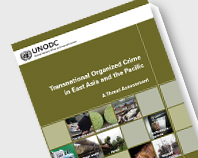 Sydney (Australia), 16 April 2013 - UNODC today launched its report, Transnational Organized Crime (TOC) East Asia and the Pacific: A Threat Assessment. This vast, populous region has experienced rapid economic and social changes during the past few decades and faced the considerable regulation challenges that these changes have created for public authorities. The report takes a look at the manner in which criminal enterprises have developed alongside legitimate commerce in recent years.
Sydney (Australia), 16 April 2013 - UNODC today launched its report, Transnational Organized Crime (TOC) East Asia and the Pacific: A Threat Assessment. This vast, populous region has experienced rapid economic and social changes during the past few decades and faced the considerable regulation challenges that these changes have created for public authorities. The report takes a look at the manner in which criminal enterprises have developed alongside legitimate commerce in recent years.
The report draws on official statistics and academic studies, as well as interviews with law enforcement and criminal justice officials. The key objective is to further the understanding about the mechanics of illicit trade: the how, where, when, who, and why of selected contraband markets affecting the region. The report also endeavours to give the best reading of the limited available data on the size of these markets, although it is a challenge to quantify them precisely due to information and data gaps.
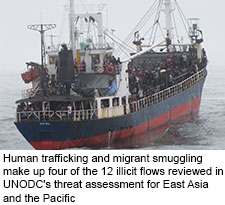 The 12 selected contraband markets covered in the report are organized under four headings, namely: people (human trafficking and the smuggling of migrants); narcotic drugs (heroin and methamphetamine); environment (wildlife, wood-based products, e-waste and ozone-depleting substances); and goods (counterfeit goods and fraudulent medicines). These contraband markets are valued at approximately US$ 90 billion.
The 12 selected contraband markets covered in the report are organized under four headings, namely: people (human trafficking and the smuggling of migrants); narcotic drugs (heroin and methamphetamine); environment (wildlife, wood-based products, e-waste and ozone-depleting substances); and goods (counterfeit goods and fraudulent medicines). These contraband markets are valued at approximately US$ 90 billion.
Drug trafficking accounts for an estimated one third of the value of TOC flows studied in this report. According to the report, an estimated 65 metric tons of heroin worth US$16.3 billion flowed within the region in 2011, of which two-thirds were produced in the Shan State of Myanmar. A significant proportion of the US$15 billion worth of methamphetamine within the region is manufactured in the region itself, although there are notable amounts entering the region from West Africa and Middle East.
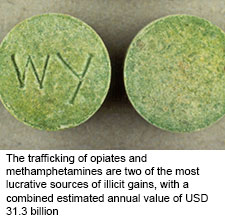 Approximately one-third of TOC flows valued at US$24.4 billion are related to counterfeit goods and another US$5 billion to fraudulent medicines. High levels of demand for counterfeit products in many different parts of the world, coupled with the region's growing economy and ability to meet this demand has been a driver for the growth of counterfeiting.
Approximately one-third of TOC flows valued at US$24.4 billion are related to counterfeit goods and another US$5 billion to fraudulent medicines. High levels of demand for counterfeit products in many different parts of the world, coupled with the region's growing economy and ability to meet this demand has been a driver for the growth of counterfeiting.
The report also examines several types of environmental crime including extractive industries such as the illegal harvesting and trafficking of wood-based products worth US$17 billion, wildlife valued at US$2.5 billion, the dumping of e-waste estimated at US$3.75 billion, and the trafficking in ozone-depleting substances of US$ 0.0677 billion. Environmental crimes are profitable forms of TOC in East Asia and the Pacific, as many countries in the region are rich in natural resources but lack the capacity to enforce laws to protect them.
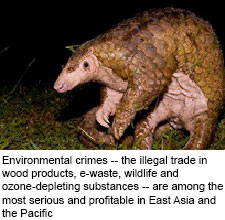 The report also sheds light on the phenomenon of smuggling of migrants and human trafficking that remain a persistent problem in the region.
The report also sheds light on the phenomenon of smuggling of migrants and human trafficking that remain a persistent problem in the region.
Following an analysis of these flows, the study concludes with 48 recommendations on how the problems can be addressed in the broad areas of understanding the problem, establishing a normative framework, building technical capacity and expanding regional partnerships.
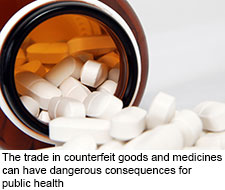 This report is a first look at major TOC flows relevant to the region and aims to contribute to policy and programme development. It is vital to integrate national responses into international strategies in order to effectively combat these issues. The United Nations Convention against Transnational Organized Crime and its Protocols, as well as the Convention against Corruption, provide useful platforms for the establishment of a normative framework to guide efforts towards capacity-building and the strengthening of regional partnerships.
This report is a first look at major TOC flows relevant to the region and aims to contribute to policy and programme development. It is vital to integrate national responses into international strategies in order to effectively combat these issues. The United Nations Convention against Transnational Organized Crime and its Protocols, as well as the Convention against Corruption, provide useful platforms for the establishment of a normative framework to guide efforts towards capacity-building and the strengthening of regional partnerships.
Further information:
Full report (pdf)
UNODC Regional Office for South-East Asia and the Pacific